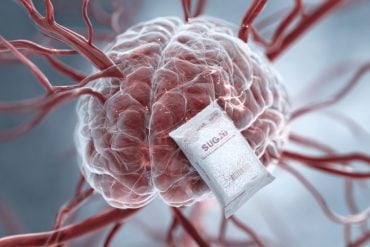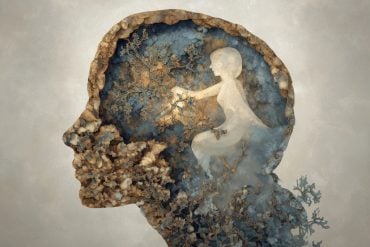Summary: A new study reports some genes associated with vascular problems are also associated with migraines.
Source: University of Helsinki.
Many of these risk variants localize inside or close to genes that regulate the vascular system.
The results of the largest genetic study on migraine thus far were published online in the journal Nature Genetics today, June 20. The study was based on DNA samples of 375,000 European, American and Australian participants. Almost 60,000 of them suffer from migraine.
The researchers combined data from 22 genome-wide association studies including new data from around 35,000 migraine sufferers. From the millions of genetic variants analyzed, 38 independent genomic regions were shown to be associated with migraine. Only ten of these regions have been implicated in migraine susceptibility before.
The study was conducted by members of the International Headache Genetics Consortium including migraine research groups from Australia, Denmark, Estonia, Finland, Germany, Iceland, the Netherlands, Norway, Spain, Sweden, the UK and USA.
“Our consortium is devoted to uncovering the genetic causes of migraine and during the past few years we have been able to identify many risk variants. Yet, in this latest, large-scale study, tens of new genetic risk factors were discovered. Because all of these variants modify the disease risk only slightly, the effect could only be seen when this large amount of samples became available,” said Professor Aarno Palotie, leader of the International Headache Genetics Consortium.
“We simply can’t overstate the importance of international collaboration when studying genetics of complex, common diseases,” continues Palotie who works as a Research Director at the Institute for Molecular Medicine Finland (FIMM), University of Helsinki, and is an associate member at the Broad Institute of MIT and Harvard.
Migraine is a debilitating disorder affecting around 1 in 7 people worldwide, but its molecular mechanisms remain poorly understood which makes developing new treatments challenging.
When the researchers took a closer look on the genomic areas pinpointed in the study, they noticed that most of them overlap with known genes. Interestingly, as many as nine of the genes have been previously associated with some vascular disease and four more are known to be involved in the regulation of vascular tone, supporting the importance of blood vessels in migraine attacks.

“These genetic findings are the first concrete step towards developing personalized, evidence-based treatments for this very complex disease. We doctors have known for a long time that migraine patients differ from each other and the drugs that work for some patients are completely inefficient for others,” said Professor John-Anker Zwart from the Oslo University Hospital.
“In the future, we hope that this information can be utilized in dividing the patients into different genetic susceptibility groups for clinical drug trials, thus increasing the chances of identifying the best possible treatment for each subgroup,” he continues.
“These interesting findings linking migraine with vascular dysfunction were generated using novel computational approaches that utilize and combine data from various international biological databases. Such datasets are invaluable in situations like this when tissue samples from patients are not readily available, underscoring the importance of data sharing,” commented Dr. Benjamin Neale from the Broad Institute of MIT and Harvard.
Source: Aarno Palotie – University of Helsinki
Image Source: This NeuroscienceNews.com image is adapted from the University of Helsinki press release.
Original Research: Abstract for “Meta-analysis of 375,000 individuals identifies 38 susceptibility loci for migraine” by Padhraig Gormley, Verneri Anttila, Bendik S Winsvold, Priit Palta, Tonu Esko, Tune H Pers, Kai-How Farh, Ester Cuenca-Leon, Mikko Muona, Nicholas A Furlotte, Tobias Kurth, Andres Ingason, George McMahon, Lannie Ligthart, Gisela M Terwindt, Mikko Kallela, Tobias M Freilinger, Caroline Ran, Scott G Gordon, Anine H Stam, Stacy Steinberg, Guntram Borck, Markku Koiranen, Lydia Quaye, Hieab H H Adams, Terho Lehtimäki, Antti-Pekka Sarin, Juho Wedenoja, David A Hinds, Julie E Buring, Markus Schürks, Paul M Ridker, Maria Gudlaug Hrafnsdottir, Hreinn Stefansson, Susan M Ring, Jouke-Jan Hottenga, Brenda W J H Penninx, Markus Färkkilä, Ville Artto, Mari Kaunisto, Salli Vepsäläinen, Rainer Malik, Andrew C Heath, Pamela A F Madden, Nicholas G Martin, Grant W Montgomery, Mitja I Kurki, Mart Kals, Reedik Mägi, Kalle Pärn, Eija Hämäläinen, Hailiang Huang, Andrea E Byrnes, Lude Franke, Jie Huang, Evie Stergiakouli, Phil H Lee, Cynthia Sandor, Caleb Webber, Zameel Cader, Bertram Muller-Myhsok, Stefan Schreiber, Thomas Meitinger, Johan G Eriksson, Veikko Salomaa, Kauko Heikkilä, Elizabeth Loehrer, Andre G Uitterlinden, Albert Hofman, Cornelia M van Duijn, Lynn Cherkas, Linda M Pedersen, Audun Stubhaug, Christopher S Nielsen, Minna Männikkö, Evelin Mihailov, Lili Milani, Hartmut Göbel, Ann-Louise Esserlind, Anne Francke Christensen, Thomas Folkmann Hansen, Thomas Werge, International Headache Genetics Consortium, Jaakko Kaprio, Arpo J Aromaa, Olli Raitakari, M Arfan Ikram, Tim Spector, Marjo-Riitta Järvelin, Andres Metspalu, Christian Kubisch, David P Strachan, Michel D Ferrari, Andrea C Belin, Martin Dichgans, Maija Wessman, Arn M J M van den Maagdenberg, John-Anker Zwart, Dorret I Boomsma, George Davey Smith, Kari Stefansson, Nicholas Eriksson, Mark J Daly, Benjamin M Neale, Jes Olesen, Daniel I Chasman, Dale R Nyholt and Aarno Palotie in Nature Genetics. Published online June 20 2016 doi:10.1038/ng.3598
[cbtabs][cbtab title=”MLA”]University of Helsinki. “New Insight Into The Cause of Migraine.” NeuroscienceNews. NeuroscienceNews, 20 June 2016.
<https://neurosciencenews.com/migraine-genetics-neurology-4524/>.[/cbtab][cbtab title=”APA”]University of Helsinki. (2016, June 20). New Insight Into The Cause of Migraine. NeuroscienceNews. Retrieved June 20, 2016 from https://neurosciencenews.com/migraine-genetics-neurology-4524/[/cbtab][cbtab title=”Chicago”]University of Helsinki. “New Insight Into The Cause of Migraine.” https://neurosciencenews.com/migraine-genetics-neurology-4524/ (accessed June 20, 2016).[/cbtab][/cbtabs]
Abstract
Meta-analysis of 375,000 individuals identifies 38 susceptibility loci for migraine
Migraine is a debilitating neurological disorder affecting around one in seven people worldwide, but its molecular mechanisms remain poorly understood. There is some debate about whether migraine is a disease of vascular dysfunction or a result of neuronal dysfunction with secondary vascular changes. Genome-wide association (GWA) studies have thus far identified 13 independent loci associated with migraine. To identify new susceptibility loci, we carried out a genetic study of migraine on 59,674 affected subjects and 316,078 controls from 22 GWA studies. We identified 44 independent single-nucleotide polymorphisms (SNPs) significantly associated with migraine risk (P < 5 × 10−8) that mapped to 38 distinct genomic loci, including 28 loci not previously reported and a locus that to our knowledge is the first to be identified on chromosome X. In subsequent computational analyses, the identified loci showed enrichment for genes expressed in vascular and smooth muscle tissues, consistent with a predominant theory of migraine that highlights vascular etiologies.
“Meta-analysis of 375,000 individuals identifies 38 susceptibility loci for migraine” by Padhraig Gormley, Verneri Anttila, Bendik S Winsvold, Priit Palta, Tonu Esko, Tune H Pers, Kai-How Farh, Ester Cuenca-Leon, Mikko Muona, Nicholas A Furlotte, Tobias Kurth, Andres Ingason, George McMahon, Lannie Ligthart, Gisela M Terwindt, Mikko Kallela, Tobias M Freilinger, Caroline Ran, Scott G Gordon, Anine H Stam, Stacy Steinberg, Guntram Borck, Markku Koiranen, Lydia Quaye, Hieab H H Adams, Terho Lehtimäki, Antti-Pekka Sarin, Juho Wedenoja, David A Hinds, Julie E Buring, Markus Schürks, Paul M Ridker, Maria Gudlaug Hrafnsdottir, Hreinn Stefansson, Susan M Ring, Jouke-Jan Hottenga, Brenda W J H Penninx, Markus Färkkilä, Ville Artto, Mari Kaunisto, Salli Vepsäläinen, Rainer Malik, Andrew C Heath, Pamela A F Madden, Nicholas G Martin, Grant W Montgomery, Mitja I Kurki, Mart Kals, Reedik Mägi, Kalle Pärn, Eija Hämäläinen, Hailiang Huang, Andrea E Byrnes, Lude Franke, Jie Huang, Evie Stergiakouli, Phil H Lee, Cynthia Sandor, Caleb Webber, Zameel Cader, Bertram Muller-Myhsok, Stefan Schreiber, Thomas Meitinger, Johan G Eriksson, Veikko Salomaa, Kauko Heikkilä, Elizabeth Loehrer, Andre G Uitterlinden, Albert Hofman, Cornelia M van Duijn, Lynn Cherkas, Linda M Pedersen, Audun Stubhaug, Christopher S Nielsen, Minna Männikkö, Evelin Mihailov, Lili Milani, Hartmut Göbel, Ann-Louise Esserlind, Anne Francke Christensen, Thomas Folkmann Hansen, Thomas Werge, International Headache Genetics Consortium, Jaakko Kaprio, Arpo J Aromaa, Olli Raitakari, M Arfan Ikram, Tim Spector, Marjo-Riitta Järvelin, Andres Metspalu, Christian Kubisch, David P Strachan, Michel D Ferrari, Andrea C Belin, Martin Dichgans, Maija Wessman, Arn M J M van den Maagdenberg, John-Anker Zwart, Dorret I Boomsma, George Davey Smith, Kari Stefansson, Nicholas Eriksson, Mark J Daly, Benjamin M Neale, Jes Olesen, Daniel I Chasman, Dale R Nyholt and Aarno Palotie in Nature Genetics. Published online June 20 2016 doi:10.1038/ng.3598






